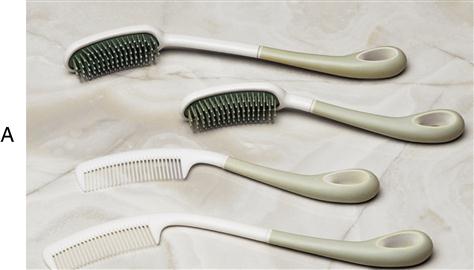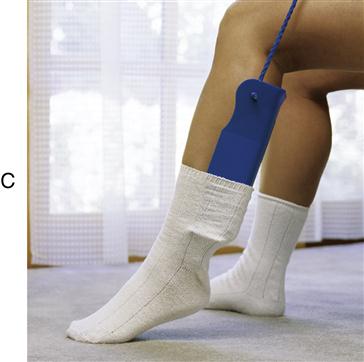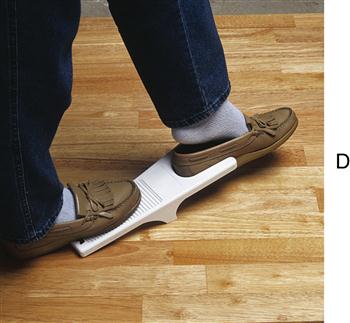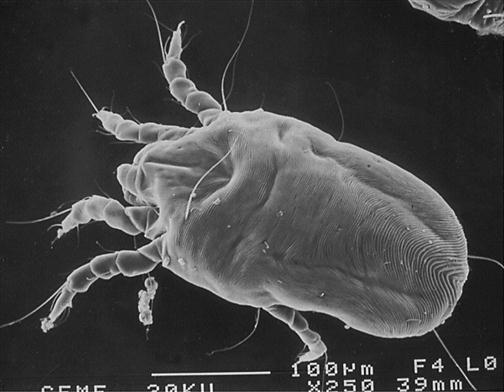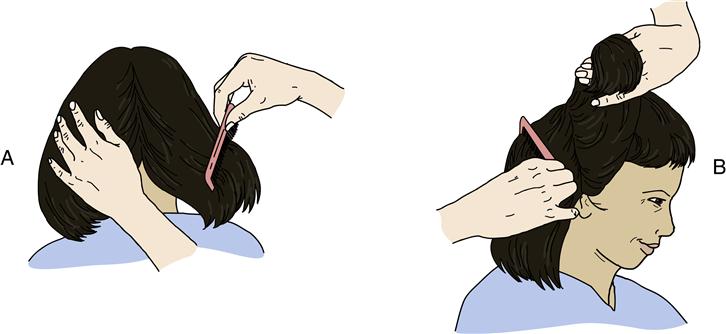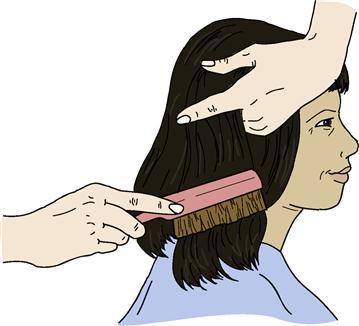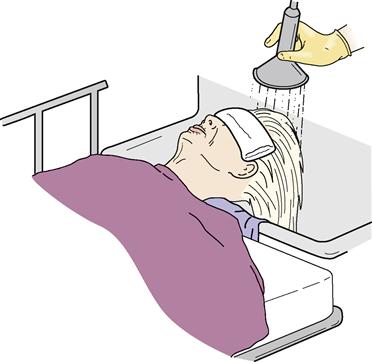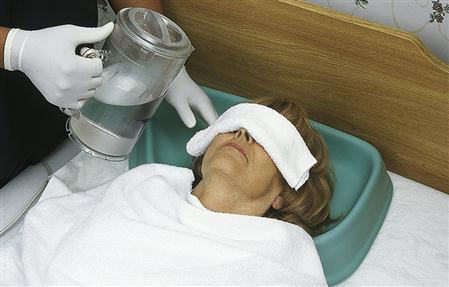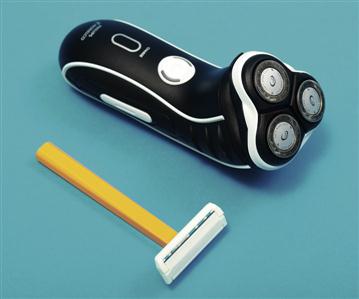Grooming
Objectives
• Define the key terms and key abbreviations listed in this chapter.
• Explain why grooming is important.
• Identify the factors that affect hair care.
• Explain how to care for matted and tangled hair.
• Describe how to shampoo hair.
• Describe the measures practiced when shaving a person.
• Explain why nail and foot care are important.
• Describe the rules for changing clothing and gowns.
• Perform the procedures described in this chapter.
Key terms
alopecia Hair loss
anticoagulant A drug that prevents or slows down (anti) blood clotting (coagulate)
dandruff Excessive amounts of dry, white flakes from the scalp
hirsutism Excessive body hair
lice See “pediculosis”
mite A very small spider-like organism
pediculosis Infestation with wingless insects; lice
pediculosis capitis Infestation of the scalp (capitis) with lice; head lice
pediculosis corporis Infestation of the body (corporis) with lice
pediculosis pubis Infestation of the pubic (pubis) hair with lice
KEY ABBREVIATIONS
| C | Centigrade |
| F | Fahrenheit |
| ID | Identification |
| IV | Intravenous |
Hair care, shaving, and nail and foot care are important to many residents. Like hygiene, these grooming measures prevent infection and promote comfort. They also affect love, belonging, and self-esteem needs.
People differ in their grooming measures. Some want only clean hair. Others want a certain hair style. Some want only clean hands. Others want clean, manicured, and polished nails. Many men shave and groom their beards. Likewise, many women shave their legs and underarms. Some women have facial hair. They may shave or use other hair removal methods.
See Focus on Rehabilitation: Grooming.
See Teamwork and Time Management: Grooming.
Hair care
How the hair looks and feels affects mental well-being. Some people cannot perform hair care. You assist with hair care whenever needed.
The nursing process reflects the person’s culture, personal choice, skin and scalp condition, health history, and self-care ability. Many nursing centers have beauty and barber shops for residents (Fig. 21-2). Residents can have their hair shampooed, cut, and styled. Men also can have their mustaches and beards groomed.
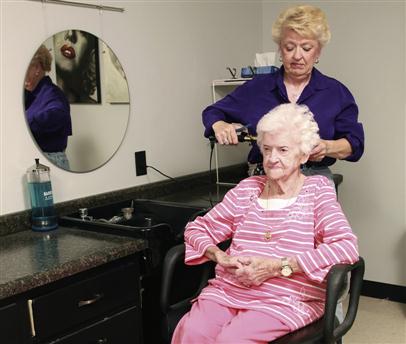
Skin and scalp conditions
Skin and scalp conditions include hair loss, excessive body hair, dandruff, lice, and scabies.
See Focus on Communication: Skin and Scalp Conditions.
Alopecia, hirsutism, and dandruff
Alopecia means hair loss. Hair loss may be complete or partial. Male pattern baldness occurs with aging. It results from heredity. Hair also thins in some women with aging. Cancer treatments (radiation therapy to the head and chemotherapy) often cause alopecia in males and females. Skin disease is another cause. Stress, poor nutrition, pregnancy, some drugs, and hormone changes are other causes. Except for hair loss from aging, hair usually grows back.
Hirsutism is excessive body hair. It can occur in women and children. It results from heredity and abnormal amounts of male hormones.
Dandruff is the excessive amount of dry, white flakes from the scalp. Itching often occurs. Sometimes eyebrows and ear canals are involved. Medicated shampoos correct the problem.
Lice
Pediculosis (lice) is the infestation with wingless insects (lice). See Figure 21-3. Infestation means being in or on a host. Lice attach their eggs (nits) to hair shafts. Nits are oval and yellow to white in color. They hatch in about one week.
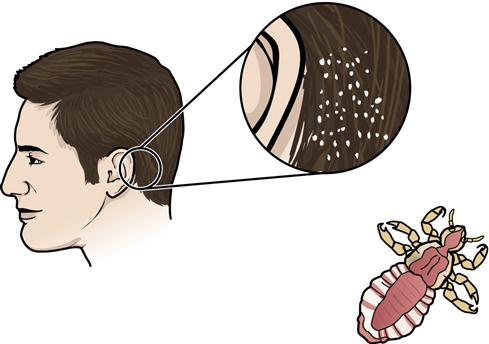
After hatching, lice feed on blood to live. Therefore they bite the scalp or skin. Adult lice are about the size of a sesame seed. They are tan to grayish-white in color. Lice bites cause severe itching in the affected body area.
Lice easily spread to others through clothing, head coverings, furniture, beds, towels, bed linen, and sexual contact. They also are spread by sharing combs and brushes. Lice are treated with medicated shampoos, lotions, and creams. Thorough bathing is needed. So is washing clothing and linens in hot water.
Report signs and symptoms of lice to the nurse at once:
Scabies
Scabies is a skin disorder caused by a female mite (Fig. 21-4, p. 314). A mite is a very small spider-like organism (Fig. 21-5, p. 314). The female mite burrows into the skin and lays eggs. When the eggs hatch, the females produce more eggs. The person becomes infested with mites.
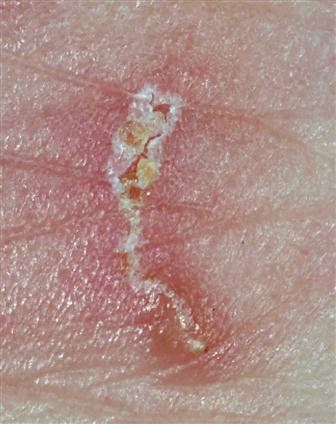
The person has a rash and intense itching. Common sites are between the fingers, around the wrists, in the underarm area, on the thighs, and in the genital area. Other sites include the breasts, waist, and buttocks.
Scabies is highly contagious. It is transmitted to others by close contact. Persons living in crowded living settings are at risk. So are persons with weakened immune systems. Special creams are ordered to kill the mites. The person’s room is cleaned. Clothing and linens are washed in hot water.
 Brushing and combing hair
Brushing and combing hair
Brushing and combing hair are part of early morning care, morning care, and afternoon care. And they are done whenever needed. Some people also brush and comb hair at bedtime. Make sure you complete hair care before visitors arrive.
Encourage residents to do their own hair care. Assist as needed. Perform hair care for those who cannot do so. The person chooses how to brush, comb, and style hair.
Brushing increases blood flow to the scalp. And it brings scalp oils along the hair shaft. Scalp oils help keep hair soft and shiny. Brushing and combing prevent tangled and matted hair. When brushing and combing hair, start at the scalp. Then brush or comb to the hair ends.
Long hair easily mats and tangles. Daily brushing and combing prevent the problem. So does braiding. You need the person’s consent to braid hair. Never cut matted or tangled hair. Never cut hair for any reason. Tell the nurse if the person has matted or tangled hair. The nurse may have you comb or brush through the matting and tangling.
Special measures are needed for curly, coarse, and dry hair. Use a wide-tooth comb for curly hair. Start at the neckline. Working upward, lift and fluff hair outward. Continue to the forehead. Wet hair or apply conditioner or petroleum jelly as directed. This makes combing easier.
The person may have certain hair care practices and hair care products. They are part of the care plan. Also, let the person guide you when giving hair care.
See Caring About Culture: Brushing and Combing Hair.
See Delegation Guidelines: Brushing and Combing Hair.
See Promoting Safety and Comfort: Brushing and Combing Hair.
 Shampooing
Shampooing
Oil gland secretion decreases with aging. Therefore older persons have dry hair. Shampooing frequency depends on the person’s needs and preferences. Usually shampooing is done weekly on the person’s bath day.
Some persons use certain shampoos and conditioners. Others used medicated products ordered by the doctor.
Residents usually need help with shampooing. If a woman’s hair is done by a hairdresser, do not shampoo her hair. She wears a shower cap during the tub bath or shower.
The shampoo method depends on the person’s condition, safety factors, and personal choice. The health team decides on the method to use.
• Shampoo on a stretcher. The stretcher is in front of the sink. A towel is placed under the neck. The head is tilted over the edge of the sink (Fig. 21-8). You use a water pitcher or hand-held nozzle to wet and rinse the hair.
• Shampoo in bed. The person’s head and shoulders are moved to the edge of the bed if possible. A shampoo tray is placed under the head to protect the linens and mattress from water. The tray drains into a basin placed on a chair by the bed (Fig. 21-9). You use a water pitcher to wet and rinse the hair. This method is used for persons who need complete bed baths. It also is used for persons who cannot use a chair, wheelchair, or stretcher.
Dry and style hair as quickly as possible after the shampoo. Women may want hair curled or rolled up before drying. Check with the nurse before doing so.
See Delegation Guidelines: Shampooing.

